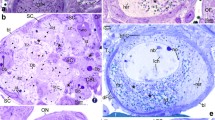Abstract
Eggs obtained from feces of rabbits infected with Strongyloides papillosus were squashed and the karyotypes were determined. They contained cells with either two long and two medium sized chromosomes (2L2M), or one long, three medium and one short chromosome (L3MS). Two types of parasitic female gonad could be distinguished on the basis of oocyte chromosome morphology at prometaphase of the maturation division. All the oocytes in a gonad contained either two upaired long chromosomes and two unpaired medium sized chromosomes, or two unpaired medium sized chromosomes and two unpaired chromosomes segmented into beads in one region. At the maturation division in mitotic parthenogenesis the beads appear to be lost from one of the chromosomes. This generates a medium sized and a shorter chromosome, which together with the undiminished chromosomes make up the L3MS karyotype. Animals with beaded oocyte chromosomes lay eggs that develop into males. It is suggested that males are heteromorphic for the long homologue due to chromatin diminution, that occurs in the maturation division of mitotic parthenogenesis.
Similar content being viewed by others
References
Albertson, D.G., Sulston, J.E., White, J.G.: Cell cycling and DNA replication in a mutant blocked in cell division in the nematode Caenorhabditis elegans. Develop. Biol. 63, 165–178 (1978)
Bolla, R.I., Roberts, L.S.: Gametogenesis and chromosomal complement in Strongyloides ratti (Nematoda Rhabdiasoidea). J. Parasitol. 54, 849–855 (1963)
Brenner, S.: The genetics of Caenorhabditis elegans. Genetics 77, 71–94 (1974)
Herman, R.K., Madl, J.E., Kari, C.K.: Duplications in Caenorhabditis elegans. Genetics 92, 415–435 (1979)
Hodgkin, J.A., Brenner, S.: Mutations causing transformation of sexual phenotype in the nematode Caenorhabditis elegans. Genetics 86, 275–287 (1977)
Moncol, D.J., Triantaphyllou, A.C.: Strongyloides ransomi: Factors influencing the in vitro development of the free-living generation. J. Parasitol. 64, 220–225 (1978)
Newmeyer, D., Galeazzi, D.R.: The instability of Neurospora duplication Dp (IL→IR) H4250, and its genetic control. Genetics 85, 461–487 (1977)
Nigon, V.: Développement et reproduction des nématodes. In: Traité de zoologie, anatomie, systématique, biologie, Tome IV (II). (P.P. Grassé, ed.), pp. 218–386. Paris: Masson et Cie 1965
Nigon, V., Roman, E.: Le déterminisme du sexe et le dévelopment cyclique de Strongyloides ratti. Bull Biol. Fr. Belg. 86, 404–448 (1952)
Roberts, F.H.S., O'Sullivan, P.J.: Methods for egg counts and larval cultures for strongyles infesting the gastrointestinal tracts of cattle. Aust. J. agric. Res. 1, 99–102 (1950)
Soulsey, E.J.L.: Textbook of veterinary clinical parasitology, Vol. I, p. 463. Oxford; Blackwell 1955
Sulston, J.E., Horvitz, H.R.: Post-embryonic cell lineages of the nematode Caenorhabditis elegans. Develop. Biol. 56, 110–156 (1977)
Triantaphyllou, A.C., Moncol, D.J.: Cytology, reproduction, and sex determination of Strongyloides ransomi and S. papillosus. J. Parasitol. 63, 961–973 (1977)
White, M.J.D.: Animal cytology and evolution, 3d edit., pp. 751–758. Cambridge: Cambridge University Press 1973
Zaffanini, F.: Parthenogenesis in the parasitic and free-living forms of Strongyloides papillosus (Nematoda, Rhabdiasoidea). Chromosoma (Berl.) 40, 443–450 (1973)
Author information
Authors and Affiliations
Rights and permissions
About this article
Cite this article
Albertson, D.G., Nwaorgu, O.C. & Sulston, J.E. Chromatin diminution and a chromosomal mechanism of sexual differentiation in Strongyloides papillosus . Chromosoma 75, 75–87 (1979). https://doi.org/10.1007/BF00330626
Received:
Accepted:
Issue Date:
DOI: https://doi.org/10.1007/BF00330626




